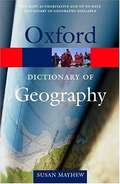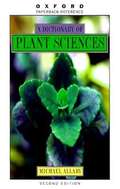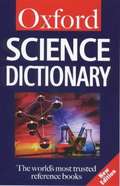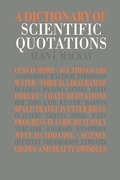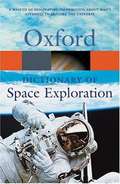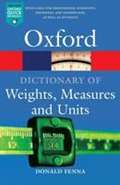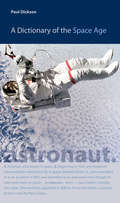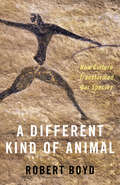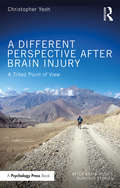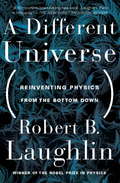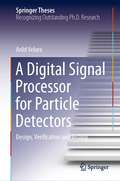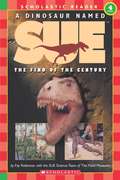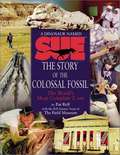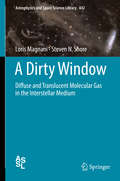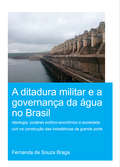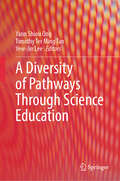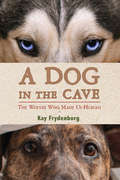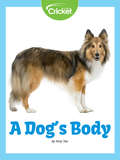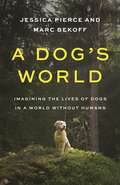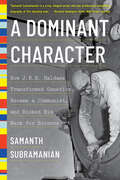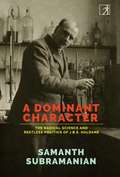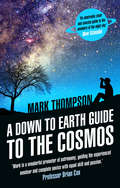- Table View
- List View
A Dictionary of Geography
by Susan MayhewThis unique new dictionary offers comprehensive coverage of words and terms encountered in both human and physical geography in a single volume. Each of the over 6,000 updated, clear, and concise entries provides an initial brief definition followed by a more in-depth explanation, making the book useful for novices and experts alike. This new edition also features a fact-finder with key economic and population statistics. Authoritative and completely accessible, A Dictionary of Geography, Second Edition covers a vast scope of subjects, including cartography, surveying, meteorology, climatology, biogeography, ecology, geology, geomorphology, population, migration, agriculture, industry, transportation, and development. There is also extensive discussion of the most recent advances in and information on topics such as plate tectonics, remote sensing, geographic information systems, and aerial differentiation. Wide-ranging and highly readable, this invaluable reference guide answers questions about all aspects,of geography quickly and effectively using the most recent advances in the field.
A Dictionary of Plant Sciences
by Michael AllabyThis is the most comprehensive and up-to-date paperback dictionary of botany available. Fully revised for this new edition, with over 5500 clear and concise entries, it will be invaluable to students, amateur botanists and naturalists, and everyone with an interest in plants and their environments. Wide coverage including biochemistry, plant physiology, cytology, ecology, genetics, evolution, biogeography, Earth history, and the Earth sciences. World-wide coverage of taxonomic groups - one-third of the entries are devoted to taxa, from bacteria and fungi to the main groups of flowering and non-flowering plants. Many new entries added from the field of molecular biology.
A Dictionary of Science (4th edition)
by Elizabeth Martin Alan Isaacs John DaintithNow in its fourth edition, this bestselling dictionary contains 9,000 entries on all aspects of science. Ideal for both students and non-scientists, it provides comprehensive coverage of biology (including human biology), chemistry, physics, the earth sciences, and astronomy. Short biographies of leading scientists Full-page illustrated features on such subjects as El Nino, the Solar System, and Genetically Modified Organisms Chronologies of specific scientific subjects including plastics, electronics, and cell biology 'The book will appeal not just to scientists and science students but also to the interested lay person. And it passes the most difficult test of any dictionary--it is well worth browsing through.' New Scientist 'All entries are clear and brief, written in no-nonsense prose A handy reference work.' TES 'Handy and readable for scientists aged nine to ninety' Nature
A Dictionary of Scientific Quotations
by Alan L. MackayScience affects us all-in the words of Albert Einstein, "The whole of science is nothing more than a refinement of everyday thinking." It is therefore fascinating to discover the thoughts of scientists, philosophers, humanists, poets, theologians, politicians, and other miscellaneous mortals on this most important of subjects. A Dictionary of Scientific Quotations is a personal selection of scientific quotations by Professor Alan L Mackay that includes graffiti, lines of song, proverbs, and poetry. Whether you believe that "All problems are finally scientific problems" (George Bernard Shaw) or that "Imagination is more important than knowledge" (Einstein), it is without doubt that "It is a good thing for an uneducated man to read books of quotations" (Churchill). You will be charmed and delighted by this collection and remember, "'Why,'" said the Dodo, "'the best way to explain it is to do it'" (Alice in Wonderland, Lewis Carroll).
A Dictionary of Space Exploration
by E. Julius DaschThis fascinating dictionary covers the exciting world of space exploration and every aspect of the technology involved. Containing over 2,500 entries it defines the jargon used in space exploration including such weird and wonderful terms as 'cherry picker' and 'burp firing'. All the entries are fully cross-referenced for ease of use, and important entries, such as the entry on the Apollo project, are presented as detailed feature articles. In addition to the main entries and definitions, the book also contains links to over 250 space-related websites, and a comprehensive chronology of space exploration. The entries are supported by over 50 photographs, illustrations and diagrams. Written by a team of experts, the entries have been edited by Dr E. Julius Dasch, former manager of the NASA National Space Grant Program. This authoritative, comprehensive and readable dictionary is essential reading for anyone with an interest in astronomy and space travel.
A Dictionary of Weights, Measures, and Units
by Donald FennaThis comprehensive and authoritative dictionary provides clear definitions of units, prefixes, and styles of weights and measures within the Systeme International (SI), as well as traditional, and industry-specific units. It also includes general historical and scientific background, covering the development of the sequential definitions and sizing of units. This new reference work will prove invaluable to professional scientists, engineers, technicians as well as to students and the general user. Over 1,600 clear and concise entries complete with historical background. Covers a broad range of disciplines, including astronomy, electromagnetics, geology, photography, mathematics, meteorology, physics, and temperature. Notes on associated terminology. Numerous tables, including the geochronologic scale and the equation of time. Comprehensive coverage of the whole Systeme International.
A Dictionary of the Space Age (New Series in NASA History)
by Paul Dickson2009 Outstanding Academic Title, ChoiceThe launch of Sputnik 1 in 1957 ushered in an exciting era of scientific and technological advancement. As television news anchors, radio hosts, and journalists reported the happenings of the American and the Soviet space programs to millions of captivated citizens, words that belonged to the worlds of science, aviation, and science fiction suddenly became part of the colloquial language. What’s more, NASA used a litany of acronyms in much of its official correspondence in an effort to transmit as much information in as little time as possible. To translate this peculiar vocabulary, Paul Dickson has compiled the curious lingo and mystifying acronyms of NASA in an accessible dictionary of the names, words, and phrases of the Space Age.Aviators, fighter pilots, and test pilots coined the phrases "spam in a can" (how astronauts felt prelaunch as they sat in a tiny capsule atop a rocket booster); "tickety-boo" (things are fine), and "the Eagle has landed" (Neil Armstrong’s famous quote when Apollo 11 landed on the Moon).This dictionary captures a broader foundation for language of the Space Age based on the historic principles employed by the Oxford English Dictionary and Webster’s New Third International Dictionary. Word histories for major terms are detailed in a conversational tone, and technical terms are deciphered for the interested student and lay reader. This is a must-own reference for space history buffs.
A Different Kind of Animal: How Culture Transformed Our Species
by Robert BoydHow our ability to learn from each other has been the essential ingredient to our remarkable success as a speciesHuman beings are a very different kind of animal. We have evolved to become the most dominant species on Earth. We have a larger geographical range and process more energy than any other creature alive. This astonishing transformation is usually explained in terms of cognitive ability—people are just smarter than all the rest. But in this compelling book, Robert Boyd argues that culture—our ability to learn from each other—has been the essential ingredient of our remarkable success.A Different Kind of Animal demonstrates that while people are smart, we are not nearly smart enough to have solved the vast array of problems that confronted our species as it spread across the globe. Over the past two million years, culture has evolved to enable human populations to accumulate superb local adaptations that no individual could ever have invented on their own. It has also made possible the evolution of social norms that allow humans to make common cause with large groups of unrelated individuals, a kind of society not seen anywhere else in nature. This unique combination of cultural adaptation and large-scale cooperation has transformed our species and assured our survival—making us the different kind of animal we are today.Based on the Tanner Lectures delivered at Princeton University, A Different Kind of Animal features challenging responses by biologist H. Allen Orr, philosopher Kim Sterelny, economist Paul Seabright, and evolutionary anthropologist Ruth Mace, as well as an introduction by Stephen Macedo.
A Different Perspective After Brain Injury: A Tilted Point of View (After Brain Injury: Survivor Stories)
by Christopher YeohWhilst preparing for his travel adventures into a world he had yet to explore, Christopher Yeoh was involved in a road traffic accident and experienced something few others would be "privileged" to witness. Eight days in a coma, more than a year in and out of hospital and a gradual re-introduction to the world of work. A Different Perspective After Brain Injury: A Tilted Point of View is written entirely by the survivor, providing an unusually introspective and critical personal account of life following a serious blow to the head. It charts the initial insult, early rehabilitation, development of understanding, the return of emotion, moments of triumph and regression into depression, the exercise of reframing how a brain injury is perceived and a return to work. It also describes the mental adjustments of awareness and acceptance alongside the physical recovery process. Readily accessible to the general public, this book will also be of particular interest to professionals involved in the care of people who have had significant brain injuries, brain injury survivors, their families and friends and also those who fund and organise health and social care. This unique author account will provide a degree of understanding of what living with a hidden disability is really like.
A Different Universe: Reinventing Physics From the Bottom Down
by Laughlin Robert B.In this age of superstring theories and Big Bang cosmology, we're used to thinking of the unknown as impossibly distant from our everyday lives. But in A Different Universe, Nobel Laureate Robert Laughlin argues that the scientific frontier is right under our fingers. Instead of looking for ultimate theories, Laughlin considers the world of emergent properties-meaning the properties, such as the hardness and shape of a crystal, that result from the organization of large numbers of atoms. Laughlin shows us how the most fundamental laws of physics are in fact emergent. A Different Universe is a truly mind-bending book that shows us why everything we think about fundamental physical laws needs to change.
A Digital Signal Processor for Particle Detectors: Design, Verification and Testing (Springer Theses)
by Arild VelureTo cope with the new running conditions in the ALICE experiment at the Large Hadron Collider at CERN, a new integrated circuit named SAMPA has been created that can process 32 analogue channels, convert them to digital, perform filtering and compression, and transmit the data on high speed links to the data acquisition system. The main purpose of this work is to specify, design, test and verify the digital signal processing part of the SAMPA device to accommodate the requirements of the detectors involved. Innovative solutions have been employed to reduce the bandwidth required by the detectors, as well as adaptations to ease data handling later in the processing chain. The new SAMPA device was built to replace two existing circuits, in addition to reducing the current consumption, and doubling the amount of processing channels. About 50000 of the devices will be installed in the Time Projection Chamber and Muon Chamber detectors in the ALICE experiment.
A Dinosaur Named Sue: The Find of the Century
by Fay RobinsonFound in the Badlands of South Dakota in 1990, "Sue" the dinosaur is the largest and most complete T-Rex fossil ever discovered. Young readers can learn about her amazing story, from the beginning to the exciting restoration work leading up to her spring 2000 debut.
A Dinosaur Named Sue: The World's Most Complete T. Rex
by Patricia RelfRelf and the SUE Science Team of The Field Museum track the story of largest and most complete T. rex fossil ever found, beginning with its discovery in 1990 in South Dakota, and leading up to its unveiling at the Field Museum in Chicago in 2000.
A Dinosaur a Day: 365 Incredible Dinosaurs to Take You Through the Year
by Miranda SmithDiscover a new dinosaur for every day of the year! The perfect gift for dinosaur fans ages 6 and up.New day, new dino! Immerse yourself in this unforgettable year-long encounter with the most astonishing creatures ever to walk the Earth.In this gorgeous calendarized collection, you&’ll find familiar and lesser-known names—from ferocious Tyrannosaurus to armored Ankylosaurus—alongside newly discovered species, all brought to life with stunning illustrations and fascinating facts.Prepare to encounter some familiar reptilian faces, as well as learn about new-to-you dinosaurs that might become new favorites. With 365 dinosaurs to take you through the year, this is the quintessential introduction to all things dinosaur.It's the ultimate gift for any dino lover, from age 6 to 106!
A Dirty Window: Diffuse and Translucent Molecular Gas in the Interstellar Medium (Astrophysics and Space Science Library #442)
by Loris Magnani Steven N. ShoreThis book provides an introduction to the physics of interstellar gas in the Galaxy. It deals with the diffuse interstellar medium which supplies a complex environment for exploring the neutral gas content of a galaxy like the Milky Way and the techniques necessary for studying this non-stellar component. After an initial exposition of the phases of the interstellar medium and the role of gas in a spiral galaxy, the authors discuss the transition from atomic to molecular gas. They then consider basic radiative transfer and molecular spectroscopy with particular emphasis on the molecules useful for studying low-density molecular gas. Observational techniques for investigating the gas and the dust component of the diffuse interstellar medium throughout the electromagnetic spectrum are explored emphasizing results from the recent Herschel and Planck missions. A brief exposition on dust in the diffuse interstellar medium is followed by a discussion of molecular clouds in general and high-latitude molecular clouds in particular. Ways of calibrating CO observations with the molecular hydrogen content of a cloud are examined along with the dark molecular gas controversy. High-latitude molecular clouds are considered in detail as vehicles for applying the techniques developed in the book. Given the transient nature of diffuse and translucent molecular clouds, the role of turbulence in the origin and dynamics of these objects is examined in some detail. The book is targeted at graduate students or postdocs who are entering the field of interstellar medium studies.
A Ditadura Militar e a Governança da Água no Brasil: Ideologia, Poderes Político-Econômico e Sociedade Civil na Construção das Hidrelétricas de Grande Porte (The Role of Ideology, Political-Economic Power and Civil Society in the Construction of Large Hydropower Dams) (IHE Delft PhD Thesis Series)
by Fernanda de Souza BragaIn recent decades there has been an exponential increase in large hydroelectric plants in Brazil, especially in the Amazon region. These large hydraulic structures impact the environment and the lives of people living in the places where they settle and require a special type of water governance. The dictatorial regime (1964-1985) created a "standard" for the construction of these great structures, through an institutional and legal framework, which benefited the Brazilian business elite but also, through the creation of a popular imagination, which shows itself lasting progress on the country's progress and development. The suspension of security, the fragility of institutional environmental structures, the disrespect for indigenous reserves, the lack of clarity about the concept of "affected population" and the non-payment of fair compensation were identified as one of the main challenges for a democratic water governance in the country. In the late 1970s, the Dam-Affected Movement (MAB) began its organization and is also studied in this research. The study is an important and insightful academic contribution to the understanding of the main bottlenecks of effective water governance in Brazil.
A Diversity of Pathways Through Science Education
by Yew-Jin Lee Yann Shiou Ong Timothy Ter Ming TanThis book presents the work of academics who contributed their work at the International Science Education Conference (ISEC) 2021, in alignment with the conference theme '20/20 Vision for Science Education Research.' Collectively, the chapters aim to evoke intellectual dialogues on current and future trends in science education. It features chapters that are grouped thematically into three sections: Questions and Questioning in Science/STEM education, Developing Science Teaching and Assessment, and History, Philosophy, and Sociology of Science/Engineering, and Informal Learning. Through the various sections, the book presents empirical studies in science and engineering classrooms or laboratories, puts forward a framework for problem-based learning, provides an account of a prominent scientist’s efforts in promoting practical science through analysis of historical documents, and uncovers trends in informal science learning space research through a review of literature. Each section is introduced by a commentary with further insights and thought-provoking questions on ideas raised in the chapters. The book also includes a 'Notes to Our Future Colleagues' section in each chapter, which presents readers with a collective vision for the state of science education research in the year 2050.
A Dog in the Cave: The Wolves Who Made Us Human
by Kay FrydenborgWe know dogs are our best animal friends, but have you ever thought about what that might mean? Fossils show we’ve shared our work and homes with dogs for tens of thousands of years. Now there’s growing evidence that we influenced dogs’ evolution—and they, in turn, changed ours. Even more than our closest relatives, the apes, dogs are the species with whom we communicate best. Combining history, paleontology, biology, and cutting-edge medical science, Kay Frydenborg paints a picture of how two different species became deeply entwined—and how we coevolved into the species we are today.
A Dog's Body
by Amy TaoDogs are amazing creatures with amazing bodies! Discover how fur protects their delicate skin, and which body parts gives them balance. Did you know dogs can wiggle their ears in many directions? Learn more facts about dogs and how their unique anatomy is different from other animals.
A Dog's World: Imagining the Lives of Dogs in a World without Humans
by Marc Bekoff Jessica PierceFrom two of the world’s leading authorities on dogs, an imaginative journey into a future of dogs without peopleWhat would happen to dogs if humans simply disappeared? Would dogs be able to survive on their own without us? A Dog’s World imagines a posthuman future for dogs, revealing how dogs would survive—and possibly even thrive—and explaining how this new and revolutionary perspective can guide how we interact with dogs now.Drawing on biology, ecology, and the latest findings on the lives and behavior of dogs and their wild relatives, Jessica Pierce and Marc Bekoff—two of today’s most innovative thinkers about dogs—explore who dogs might become without direct human intervention into breeding, arranged playdates at the dog park, regular feedings, and veterinary care. Pierce and Bekoff show how dogs are quick learners who are highly adaptable and opportunistic, and they offer compelling evidence that dogs already do survive on their own—and could do so in a world without us.Challenging the notion that dogs would be helpless without their human counterparts, A Dog’s World enables us to understand these independent and remarkably intelligent animals on their own terms.
A Dominant Character: The Radical Science And Restless Politics Of J. B. S. Haldane
by Samanth SubramanianA biography of J. B. S. Haldane, the brilliant and eccentric British scientist whose innovative predictions inspired Aldous Huxley’s Brave New World. J. B. S. Haldane’s life was rich and strange, never short on genius or drama—from his boyhood apprenticeship to his scientist father, who first instilled in him a devotion to the scientific method; to his time in the trenches during the First World War, where he wrote his first scientific paper; to his numerous experiments on himself, including inhaling dangerous levels of carbon dioxide and drinking hydrochloric acid; to his clandestine research for the British Admiralty during the Second World War. He is best remembered as a geneticist who revolutionized our understanding of evolution, but his peers hailed him as a polymath. One student called him “the last man who might know all there was to be known.” He foresaw in vitro fertilization, peak oil, and the hydrogen fuel cell, and his contributions ranged over physiology, genetics, evolutionary biology, mathematics, and biostatistics. He was also a staunch Communist, which led him to Spain during the Civil War and sparked suspicions that he was spying for the Soviets. He wrote copiously on science and politics in newspapers and magazines, and he gave speeches in town halls and on the radio—all of which made him, in his day, as famous in Britain as Einstein. It is the duty of scientists to think politically, Haldane believed, and he sought not simply to tell his readers what to think but to show them how to think. Beautifully written and richly detailed, Samanth Subramanian’s A Dominant Character recounts Haldane’s boisterous life and examines the questions he raised about the intersections of genetics and politics—questions that resonate even more urgently today.
A Dominant Character: The Science and Politics of J.B.S. Haldane
by Samanth SubramanianJ.B.S. Haldane, scientist extraordinaire—born in Britain yet spiritually bound to India—remains one of the most enigmatic geniuses of the modern era. Here is a man who saw action in two world wars, engaged in the most radical politics of his day, conducted groundbreaking scientific research, and wrote with flair and conviction—yet Haldane&’s universe remains shrouded in mystery. <P><P>Award-winning author Samanth Subramanian’s latest offering undoes this travesty. Besides shedding light on Haldane’s contributions to genetics and evolutionary biology—he was the first to calculate the rate at which mutations occur and accumulate in genes—the book illuminates Haldane&’s inner world—his towering intellect, his radical vision of society, his provocative philosophy, and his attempts a wrestling with the essential moral questions that scientific progress must raise. <P><P>Equally, the book dwells on Haldane’s years in India—his journey to the nation; his affiliation with the Indian Statistical Institute, Calcutta; his attachment to the Genetics and Biometry Laboratory in Bhubaneshwar (where he died). Dronamraju’s description of Haldane as ‘the last man who knew everything’ was, at its simplest, an acknowledgement of his command over multiple subjects. But it was also an astute observation that Haldane’s era was the last time when the realms of scientific knowledge were limited enough for a single person to apprehend in near-entirety. To know everything was to see the forces of the world unified and to conceive of life in its full complexity. A Dominant Character will give readers a taste of that heady sensation.
A Down to Earth Guide to the Cosmos
by Mark ThompsonTo the beginner, the star-filled night sky can seem mysterious and unfathomable. But with this book as a guide the awesome nature of the Cosmos is brought down to Earth. Over the course of twelve chapters Mark Thompson, one of the presenters on BBC One’s Stargazing Live and the resident astronomer on ITV’s The Alan Titchmarsh Show, will take you on a journey through space, tackling the key concepts of astronomy and unlocking the secrets of the sky. From the origins of our Universe to the ever evolving techniques used to explore deep space, A Down to Earth Guide to the Cosmos traces the journey of galactic discovery that has obsessed mankind for thousands of years.Accompanying the narrative, a series of monthly sky guides focus on the astronomical highlights visible at each given time of year, with handy charts to show you exactly what to look for and how to navigate around the sky at night. As fascinating as it is accessible, A Down to Earth Guide to the Cosmos is a must for anyone who gazes up and wishes they knew more about the final frontier...
A Dream of Flight: Alberto Santos-Dumont's Race Around the Eiffel Tower
by Rob Polivka Jef PolivkaDebut nonfiction duo Rob and Jef Polivka offer an illustrated madcap adventure in A Dream of Flight, a dynamic biography of Alberto Santos-Dumont, an inventor who risked everything to reach the skies. And sure enough, his successes and failures brought the world’s people closer together.Ready? Set. Fly! At the turn of the twentieth century, no aviation prize was more coveted in Europe than the Deutsch Prize. To win it, a pilot would have to fly a balloon from Paris’s Aero Club around the Eiffel Tower and back in thirty minutes or less. Who would be the first to succeed?Alberto Santos-Dumont thought he could. His latest design, Airship No. 6, was perfected from the countless lessons he learned during previous crashes. On the morning of October 19, 1901, Santos was making good time in the race when disaster struck—his motor had sputtered to a stop mid-air! Would Santos make it to the finish line in time—let alone survive?
A Dynamical Perspective on the ɸ4 Model: Past, Present and Future (Nonlinear Systems and Complexity #26)
by Jesús Cuevas-Maraver Panayotis G. KevrekidisThis book presents a careful selection of the most important developments of the \phi^4 model, offering a judicious summary of this model with a view to future prospects and the challenges ahead. Over the past four decades, the \phi^4 model has been the basis for a broad array of developments in the physics and mathematics of nonlinear waves. From kinks to breathers, from continuum media to discrete lattices, from collisions of solitary waves to spectral properties, and from deterministic to stochastic models of \phi^4 (and \phi^6, \phi^8, \phi^12 variants more recently), this dynamical model has served as an excellent test bed for formulating and testing the ideas of nonlinear science and solitary waves.
